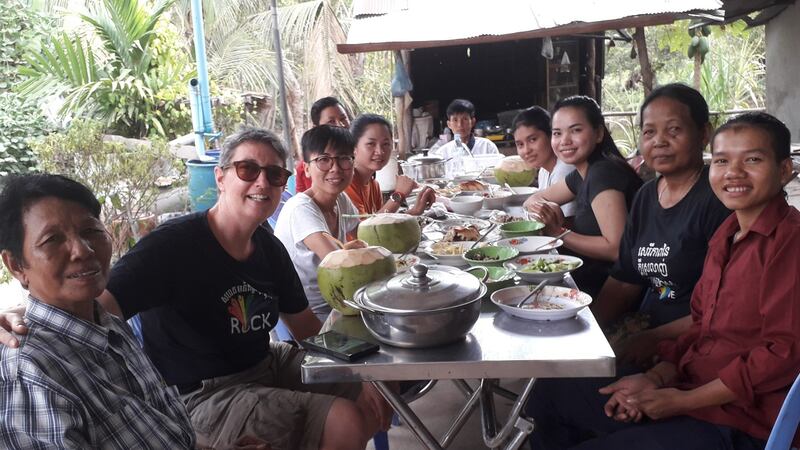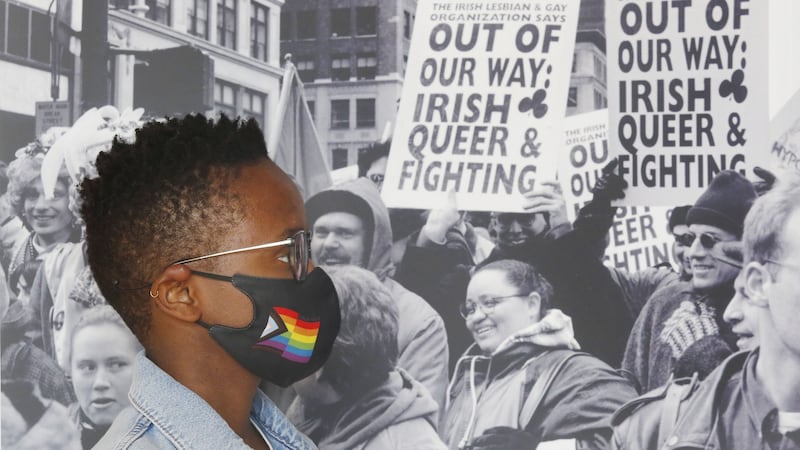“In my age group people went abroad or to Dublin to come out. Most people went to London. Rakes of Irish lesbian and gay people, who’d go back into the closet when they were going home for Christmas. They’d settle over there then, and never come home, really.”
But Collette O’Regan’s story was different – she went abroad for development work. “And no way I was going to Nigeria in the 1990s to come out. I felt I just swapped the closet.”
O’Regan’s life, evocative of one gay emigrant experience, is one of many in a new exhibition looking at the Irish diaspora experience through the LGBTQ+ lens. What was hidden and painful in the past is now more out, and well worth examination. Emigration is part of the Irish story, and Out in the World: Ireland’s LGBTQ+ Diaspora aims to tell a more complete and inclusive story about emigration by documenting the extraordinary lengths people went to seeking love, recognition and security.

My Cambodian friends were amazed at the concept of referendum, that you could change the constitution of a country
A collaboration between the Department of Foreign Affairs (DFA) and Epic, The Irish Emigration Museum, it’s curated by Dr Maurice Casey, currently the DFA’s historian-in-residence at Epic.
He set out to recognise and celebrate an LGBTQ+ history of the Irish emigration story, taking a thematic rather than a chronological approach, around six themes: exclusion, community, love, defiance, solidarity and return, to represent significant aspects of this diaspora experience.
“I wanted to complicate an idea of historical linear progress,” he says, pointing out that “of course, there is still more work to be done in making Ireland a truly equal nation”.
Those six themes are explored via personal stories, resulting in a hugely varied breadth of histories. Collette O’ Regan’s is one them. Hers is a global justice passion (“I am more than my sexuality”) and she has worked in development for years in Nigeria and Cambodia. As a teenager in Cork in the 1980s, she censored her life massively, she says. Unlike gay men, lesbians were not criminalised, “but they might as well have been. The law had the same chilling effect.”
Diverse recruitment
With Voluntary Services Overseas (VSO) – its diverse recruitment contrasted with the Irish Agency for Personal Service Overseas then, she says – she worked in development in Nigeria. While she shared her truth with VSO friends, who were supportive, it was later, back in Ireland, that she finally came out, first with Dundalk Outcomers LGBTQ+ group, and later to her family in Cork. That was her 30th birthday present to herself, “to be the problem, to disappoint them, to be awkward”.
Since Ireland’s marriage equality referendum, things have been so much better for her generation and their families, she says. “It lifted the stigma and shame for our family members. It made it okay. Ireland is not judging any more.”
Waiting on the referendum results, she was in a bar in Phnom Penh with friends from Rainbow Community Kampuchea (RoCK), which she helped set up, was the first Cambodian LGBTQ+ organisation with official state recognition.
“My Cambodian friends were amazed at the concept of referendum, that you could change the constitution of a country. And that people were doing it for LGBTQ rights was very inspiring. It gave hope across the world for us, for those who felt change will never happen here. It gave hope that religion and the state can separate.”

Within this show there are so many incredible individuals whose acts of defiance have quite literally built this world that we now get to exist in
While Buddhism has no doctrine on homosexuality, and there’s no Cambodian law against it, “cultural norms and taboos and religion overlap”. Now working with LGBT Ireland, O’Regan says that, for gay asylum seekers particularly, she’s “aware of where they coming from” and is proud they feel freedom in Ireland.
Civil war poet
Others profiled in Out in the World – and emblematic of different threads of experience – include the Brixton Faeries, a gay theatre troupe in the 1970s; American civil war soldier Peter Doyle, from Limerick, who became close to the poet Walt Whitman; and trans healthcare pioneer and Buddhist monk Michael Dillon, born in 1915 and the first known transmasculine person to have genital reconstruction surgery.
Poet, labour activist and suffragist Eve Gore-Booth (Constance Markievicz’s sister) and her partner Esther Roper were ahead of their time on gender identity. Gavin Arthur, grandson of a US president, travelled to Civil War Ireland, living here for years. There’s Stonewall rebellion participant John O’Brien (“The Irish rebel spirit was in me”); Bridget Coll, who left Ireland to become a nun and became a pioneer of Canadian immigration reform; and US Aids activist Robert Rygor, who visited Ireland but was disappointed to face the same stigma in his ancestral home.
The Irish Lesbian and Gay Organization in the US, which led campaigns challenging the exclusion of Irish LGBTQ+ people in the official New York St Patrick’s Day parades, also figures. Casey says: “Emigration was hugely important for people to live openly abroad, and that’s reflected in a lot of the stories, particularly those cities prominent in the exhibition. London, New York, Sydney were particularly important spaces for LGBT people” to live openly.
“Within this show there are so many incredible individuals whose acts of defiance have quite literally built this world that we now get to exist in,” says Irish designer and multi-disciplinary artist Richard Malone, whose series of self-portraits for the exhibition “assert my own understanding and identity as a queer Irish emigrant”.
He says: “It seems simple but it certainly isn’t, and having the historical element of the show really places queerness at the centre of Irish culture and within all of the radical changes that are happening in modern Ireland.”
‘Abhorrent and archaic’
Malone was interested in “ideas or stereotypes attached to gender and ‘queerness’, which I sometimes find really abhorrent and archaic. But they also exist and are real in some people’s minds.”
The stereotypes are “often internalised in the contemporary queer community, with a hierarchy of values placed on traditional male archetypes – it often feels deeply unradical and unprogressive”. His portraits involve “a certain amount of fabrication and theatre”, from tights and frilled jerseys to silk organza, or abstract padded shapes.

Emigrants inspired those at home by fighting for change abroad. Many returned home with models of community and activism that transformed the nation
“The queer part of my identity, which is extremely important to me” is often edited out or completely overlooked, Malone observes. “Press are much more interested in fetishising ‘working-class’ or ‘rural Irish’, like every artist or designer has a box that they mustn’t stray out of. It’s really important for us to prove that queer people get to be individuals and exceptional, and consistently so. Our understanding and existence in the world is nuanced and radical and brilliant, and can actually be full of love and support and emotional intelligence.”
Casey’s expertise is the history of Irish contributions to radical and progress movements abroad in the 20th century, and at Epic he’s focusing on giving “rightful prominence to historically marginalised communities” in the story of the Irish diaspora. (His work also highlights Irish Travellers abroad, the African-American Irish community and Irish Jewish histories.)
He says Out in the World aims to start a conversation. It sits within the State’s Global Ireland strategy to celebrate diversity in the diaspora.
“Emigrants inspired those at home by fighting for change abroad. Many returned home with models of community and activism that transformed the nation.”
For Malone, “it feels really vital to me to humanise the people who have tirelessly fought and worked for our rights to love and to exist, and to acknowledge and celebrate the place that Ireland is becoming”.
Out in the World: Ireland’s LGBTQ+ Diaspora is at Epic, The Irish Emigration Museum, Custom House Quay, Dublin 1, June 8-Dec 1, Free admission this month, celebrating Pride; thereafter included in Epic ticket. The exhibition is also on display at Irish consulates and embassies worldwide.
[ outintheworld.ieOpens in new window ]
The exhibition coincides with the National Library of Ireland’s year-long Living with Pride, exploring Irish LGBTI+ identity and experience, at the National Photographic Archive, Temple Bar, Dublin 2.









